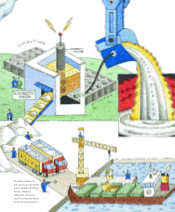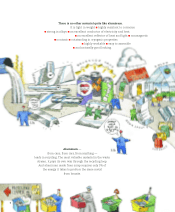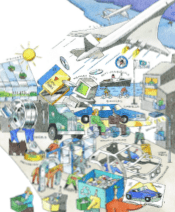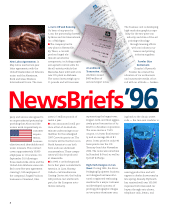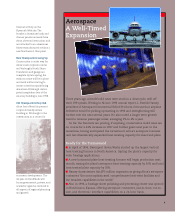Alcoa 1996 Annual Report Download - page 17
Download and view the complete annual report
Please find page 17 of the 1996 Alcoa annual report below. You can navigate through the pages in the report by either clicking on the pages listed below, or by using the keyword search tool below to find specific information within the annual report.
15
Beverage Cans Take to TV.
Television advertising co-spon-
sored by Alcoa and other
aluminum companies through
the U.S. Aluminum Association
promoted the advantages of
aluminum beverage cans
over other packages. The cam-
paign — “You Get More Out of
a Can” — reminds consumers
of the aluminum can’s conve-
nience, ability to keep products
fresher, and unrivaled recy-
cling record.
New Consumer Package. Alcoa
Aluminio has developed a spe-
cial package — a rectangular
one-liter plastic bottle and
customized plastic closure —
for CPC Company, the large
distributor of Mazola corn oil
in the Brazilian market. The
bottle’s unusual shape was
designed not only for market
appeal but also for functional
reasons. Its rectangular cross
section improves rigidity and
allows more compact stacking,
for efficient transportation and
display. The closure, a flip-top
version, was designed for oil
flow control and drop control
when serving.
Alumar Celebrates the
Environment. Alcoa Aluminio’s
Alumar refinery and smelter
complex at São Luis, Brazil has
opened an environmental
park with 4,500 acres of native
forest and more than 200
species of flora, insects, birds
and animals. The first park in
the Maranhão region to be built
inside a plant site, this environ-
mental center is open to
employees and their families,
students, scientists, and the
community. There are two
buildings for ecological infor-
mation and activities, an
amphitheater, accommoda-
tions for scientists, a nursery,
and composting and earth-
worm areas. Two educational
paths through the native forest
and its ecosystems are the
park’s main attraction. Alumar
produces 1.3 million mt of
alumina and 362,000 mt of
aluminum annually.
Environmental Research. The
U.S. Department of Energy has
awarded Alcoa a three-year,
$440,300 contract to study soil
remediation. Focus of the study
will be naturally occurring
processes that biodegrade PCBs
in soils, sludges, and sedi-
ments — and ways to accelerate
these processes. Alcoa will part-
ner with the State University of
New York at Buffalo. The award
recognizes Alcoa’s leading edge
research in effective treatment
of PCB contamination through
the use of biological processes.
‘Paws to Recycle.’ Alcoa, along
with Friskies PetCare and the
American Humane Association,
sponsored the third annual
“Paws to Recycle” campaign in
1996. This program rewards the
used aluminum beverage can
recycling efforts of local animal
shelters with cash prizes and
free pet food. In the first three
years of the collection drive,
animal shelters in 46 states
raised more than a million
dollars in operating funds and
recycled over three million
pounds of aluminum cans.
Progress Report
How Aluminum
Cuts Auto Emissions
Alcoa’s push toward the age of the aluminum car is a drive for
growth in an enormous market. And it’s more than that.
By designing with aluminum, carmakers reduce the weight
of their vehicles. Lighter cars burn less fuel. And that means
lower emissions — less carbon dioxide, nitrogen compounds,
sulfuric acid, and particulates coming from the tailpipe.
For the 1996 model year, new cars and trucks built in North
America used about 3.6 billion pounds of aluminum. Resulting
reductions in vehicle weight will save enough fuel over the life
of these vehicles to eliminate 50 billion pounds of auto-related
emissions. For the 1997 model year, increased aluminum
usage in cars will mean even greater reductions in emissions.
If the trend to aluminum continues — if, for example, all of
the world’s fleet of 450 million cars were eventually to shed
20% of their weight through aluminum-intensive design — the
world could run 55 million more cars without adding to fuel
consumption or emissions.


